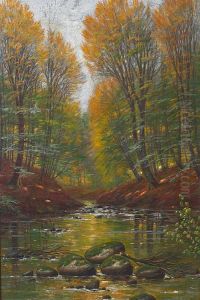Wilhelm Ferdinand Leisner Paintings
Wilhelm Ferdinand Leisner was a German artist known for his work as a painter, graphic artist, and sculptor. Born on August 20, 1907, in Nuremberg, Germany, he developed an early interest in the arts. Leisner's formative years coincided with a tumultuous period in German history, marked by the aftermath of World War I, the rise of the Weimar Republic, and the subsequent ascent of the Nazi regime.
Leisner received his artistic training at the Nuremberg School of Arts and Crafts, where he mastered various techniques that would inform his diverse body of work throughout his career. He continued to develop his skills and artistic philosophy during the interwar period, a time when German art was characterized by significant movements such as Expressionism, Dadaism, and New Objectivity.
Despite the repressive cultural policies of the Nazi era, which sought to control and dictate the direction of German art, Leisner managed to continue his practice. His work from this period often reflected the tensions and challenges faced by artists under an authoritarian regime, and he was known for his ability to blend traditional themes with a modernist sensibility.
After World War II, Leisner's art evolved in response to the changed political and social landscape of postwar Germany. He became part of the rebuilding of German culture and was an active participant in the renaissance of German art. His postwar works often displayed a sense of reflection and a search for meaning, which resonated with a society working through the trauma of the conflict and the Holocaust.
Throughout his career, Leisner exhibited his work widely, both in Germany and internationally. His contributions to the art were recognized with several awards and honors, and his pieces are included in various public and private collections.
Wilhelm Ferdinand Leisner passed away on June 5, 1996, in Nuremberg, leaving behind a legacy that encapsulates a complex period in German history. His art remains a testament to his skill and his ability to adapt and respond to the changing currents of his time.
